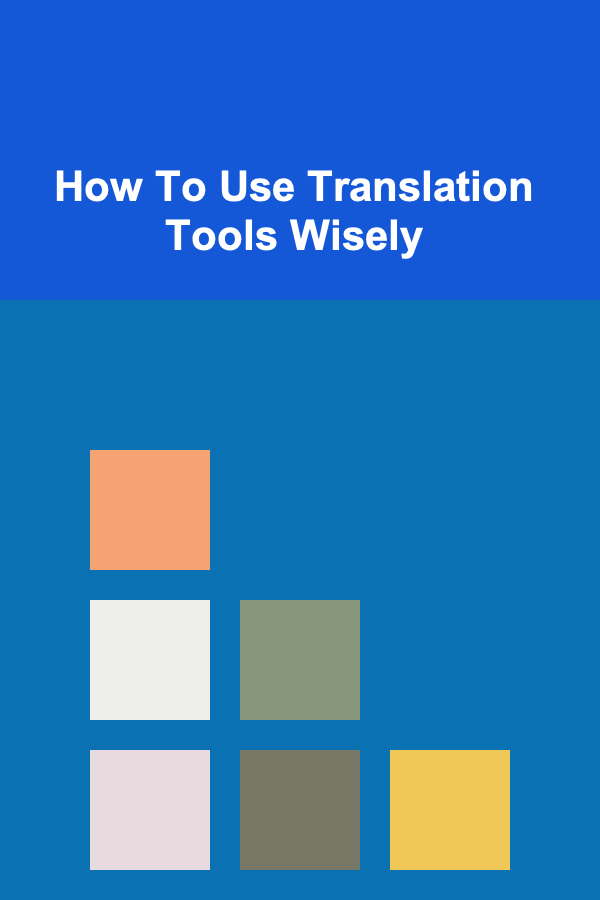
How To Use Translation Tools Wisely
ebook include PDF & Audio bundle (Micro Guide)
$12.99$6.99
Limited Time Offer! Order within the next:

In today's globalized world, effective communication across different languages is crucial. Translation tools have made it easier than ever to bridge language barriers, enabling people to communicate, learn, and engage with content in foreign languages. Whether you're a student learning a new language, a business professional negotiating a deal overseas, or a casual traveler exploring new cultures, translation tools can be incredibly helpful. However, like any tool, their use needs to be approached with caution and wisdom to maximize their benefits and minimize their limitations.
This article will explore how to use translation tools wisely by understanding their strengths, recognizing their limitations, and applying them in a way that enhances communication without compromising accuracy or nuance.
Understanding the Basics of Translation Tools
What Are Translation Tools?
Translation tools, also known as machine translation (MT) tools, are software applications that automatically translate text from one language to another. These tools use algorithms and vast databases of linguistic data to analyze and convert sentences, phrases, or entire documents from a source language into a target language.
There are two primary types of translation tools:
- Machine Translation (MT): Machine translation involves algorithms that translate text automatically based on statistical models, neural networks, or rule-based systems. Popular examples include Google Translate, DeepL, and Microsoft Translator.
- Computer-Assisted Translation (CAT): CAT tools are designed to aid human translators by providing them with a set of features such as translation memory, glossary management, and quality assurance tools. CAT tools are widely used by professional translators, such as SDL Trados or MemoQ.
How Do Translation Tools Work?
Translation tools typically rely on one of three approaches:
- Rule-Based Translation: This approach uses a predefined set of rules to convert sentences from one language to another. It is often slower but offers a more controlled translation.
- Statistical Machine Translation (SMT): SMT uses large databases of bilingual texts to statistically predict the most likely translation of a word or phrase based on patterns in the data. This method is more flexible and can be faster than rule-based systems.
- Neural Machine Translation (NMT): The latest and most advanced approach, NMT uses deep learning algorithms to understand context and produce more natural, fluent translations. NMT is behind the success of tools like Google Translate and DeepL, which have significantly improved translation quality in recent years.
While these tools have become remarkably powerful, they still face challenges, particularly in handling nuances, idiomatic expressions, and context.
Benefits of Translation Tools
Translation tools offer several key benefits that make them indispensable in our everyday lives.
1. Speed and Convenience
Translation tools allow users to quickly translate large volumes of text in seconds. This is especially valuable when you're in a time crunch, such as when you're trying to understand a foreign article, email, or webpage. These tools provide instant results that allow for immediate communication, making them ideal for time-sensitive situations.
2. Cost-Effectiveness
Hiring professional translators can be costly, especially for large documents or frequent translation needs. Translation tools, by contrast, are often free or available at a fraction of the cost of human translation services. For individuals and small businesses with limited budgets, these tools provide an affordable way to access translated content.
3. Access to Global Information
One of the most significant advantages of translation tools is that they open the door to the vast amount of content available in other languages. Whether it's reading a foreign research paper, understanding a foreign news story, or learning from a tutorial in a language you don't speak, translation tools help you break down linguistic barriers and gain access to a world of knowledge.
4. Increased Global Connectivity
For businesses looking to expand into international markets, translation tools can facilitate communication with clients and customers in different countries. Similarly, individuals can use translation tools to communicate with people across language barriers, whether it's for travel, socializing, or professional purposes. Translation tools make it possible to form meaningful connections with people from diverse backgrounds.
The Limitations of Translation Tools
While translation tools are undoubtedly powerful, they come with a range of limitations that users should be aware of. Over-reliance on these tools can result in miscommunication, inaccuracies, and frustration.
1. Loss of Nuance and Context
One of the most significant drawbacks of translation tools is their inability to fully capture the nuances and context of language. Many languages have words or phrases that don't have a direct equivalent in other languages, and machine translation often struggles to convey the full meaning. For example, idiomatic expressions or cultural references can be translated literally, leading to awkward or inaccurate results.
Consider the phrase "break a leg" in English. In a literal translation, the phrase would likely be understood as something negative in other languages. However, the idiomatic meaning of "good luck" would likely be lost in a machine translation.
2. Inaccuracies and Mistakes
Translation tools are not perfect. They can often make mistakes, especially when dealing with complex sentence structures, specialized jargon, or languages that are less common. For example, legal or medical texts require precision, and a mistranslation could have serious consequences in these fields.
Even though neural machine translation has made great strides in improving quality, the tools still make errors, particularly when translating between languages with vastly different syntaxes and grammatical structures.
3. Lack of Cultural Sensitivity
Translation tools may not account for cultural differences or context-specific considerations, which can lead to misunderstandings. For example, a translation tool might fail to recognize when a phrase is intended to be humorous, sarcastic, or formal. Additionally, cultural norms around politeness, respect, or hierarchy can affect how a translation should be phrased, which machine translation may overlook.
4. Limited Support for Less Common Languages
While tools like Google Translate support a large number of languages, they are still limited in their ability to accurately translate less widely spoken languages. For languages with fewer resources or fewer speakers, the database for translation may not be as comprehensive, leading to inaccurate or incomplete translations.
How To Use Translation Tools Wisely
To make the most out of translation tools while avoiding common pitfalls, users must approach them thoughtfully. Here are some practical strategies for using translation tools wisely.
1. Use Translation Tools as a Starting Point, Not the Final Solution
Translation tools should be used as a starting point for understanding a text in another language, but they should not be relied upon as the sole method of translation. For important documents, it's always a good idea to have a human translator review the work. Human translators can catch nuances, context, and cultural references that a machine might miss.
For casual, everyday translation needs---like translating an email or a social media post---translation tools can provide a quick and useful approximation. However, if you are dealing with formal content (such as legal contracts, medical documents, or academic papers), professional human translators should be consulted.
2. Double-Check Translations
Whenever you use a translation tool, it's important to double-check the results. If you don't speak the language fluently, it can be helpful to ask someone who does to verify the translation. Alternatively, use multiple translation tools to compare results. This can help you identify any inconsistencies or errors in the machine-generated text.
Additionally, keep in mind that translation tools often allow users to adjust the text, suggest alternative phrases, or refine the translation. These features can be useful for fine-tuning translations to better fit the intended meaning.
3. Understand the Limitations of Machine Translation
It's essential to recognize that machine translation has its limitations. Be mindful of the context in which you are using it, and don't expect it to always be accurate. Machine translation is excellent for getting the general gist of a text, but it may not always be appropriate for more detailed or technical content.
4. Consider the Purpose of the Translation
Before relying on a translation tool, ask yourself what the purpose of the translation is. Are you simply looking to get a rough understanding of a text, or do you need an accurate and polished translation? For informal communication---like travel or casual conversations---machine translation can work well. However, for professional or sensitive matters, you may want to use more reliable methods.
5. Be Aware of Privacy Concerns
Many translation tools require users to input text into their platforms, which can pose privacy concerns. Some translation tools may collect data for commercial purposes or store your translations for future use. If privacy is a concern, especially when translating sensitive information, make sure to use tools with strong privacy policies, or consider offline translation options.
Conclusion
Translation tools have revolutionized the way we communicate across language barriers, providing instant access to information, facilitating cross-cultural exchange, and enhancing global connectivity. However, like all tools, they have limitations and should be used thoughtfully.
By understanding the strengths and weaknesses of translation tools, you can use them wisely and responsibly. Treat them as a valuable resource for understanding foreign texts, but don't rely on them as your sole method of translation. Always verify important translations, consider cultural nuances, and seek professional assistance when necessary. With the right approach, translation tools can be a powerful aid in your global interactions while minimizing the risk of miscommunication and inaccuracies.

How to Make Money Online as a Digital Art Creator: 10 Actionable Ideas
Read More
How to Organize Your Craft Room for Efficient Storage
Read More
How to Save Energy with Smart and Efficient Lighting Solutions
Read More
How to Use Binders to Organize Your Favorite Recipes
Read More
How to Use Shelf Risers for Better Visibility
Read More
10 Tips for Cleaning and Maintaining Your Hearing Aids
Read MoreOther Products

How to Make Money Online as a Digital Art Creator: 10 Actionable Ideas
Read More
How to Organize Your Craft Room for Efficient Storage
Read More
How to Save Energy with Smart and Efficient Lighting Solutions
Read More
How to Use Binders to Organize Your Favorite Recipes
Read More
How to Use Shelf Risers for Better Visibility
Read More